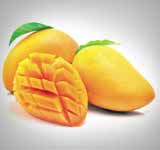1. Black mulberry
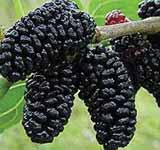
The black mulberry (Morus nigra) is a plant from the mulberry family (Moraceae) that occurs naturally in Central and West Asia, but is widely grown in Southern Europe. The black mulberry has a dark orange bark with wide grooves, and fibrous edges and nodules. It has a short trunk which can reach a height of 12 meters and is hardy to -20°C. The crown is low and dome-shaped with rough, twisted branches. The twigs are firm and downy. They color from pale green to brown. There is large, egg to cone-shaped buds with a glossy dark brown color. The leaves are heart-shaped and have toothed or lobed edges. The leaf stalks are hairy and approximately 2 cm long. The leaf is deep green from above and pale at the bottom. The bottom is also hairy. Male and female flowers are in separate catkins with a pale color.
2. Blackberry
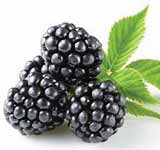
The cultivated blackberry, which is grown for the fruits, originated from crosses between different types of bramble, which means that no generic name can be given to it. Usually the varieties of the blackberry are therefore classified in Rubus section Moriferi. In addition to fresh consumption, blackberries are also frozen or processed into juice, blackberries in light syrup and jam. The fresh blackberries can only be kept for a few days.
3. Cherry
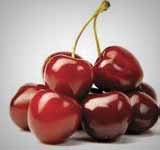
The cherry is a small, spherical fruit that usually contains a seed. Technically it is a stone fruit. All cherries are therefore cherries by definition, but not all cherries are also cherries. There is also a white cherry: the white belly. Almost nothing is known about the history of the cherry. They became known in the west after they were brought by the Roman Lucius Licinius Lucullus from Kerasunta in the Pontus, northeastern Anatolia, around the year 70 BC.
4. Coconut
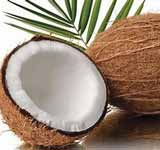
5. Grape
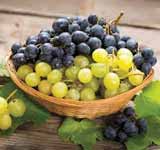
The grape is the berry fruit of the vine (Vitis vinifera) that belongs to the vine family (Vitaceae). The plant is a climbing plant. In addition to the wild vine, there are many cultivars that are cultivated as a grape vine, also known as a vine. From these cultivated varieties, grapes are grown for several purposes. Most grapes come from countries and regions with a mild to Mediterranean climate, for example those in the Mediterranean region such as Spain, France, Italy, Greece and Turkey. Certain regions in Germany, such as along the Rhine and the Moselle, also lend themselves well to grape growing, because the temperature on the southern slopes of the river is always a few degrees higher than in the regions outside.
6. Guava
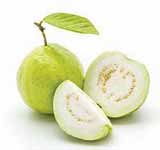
7. Jackfruit
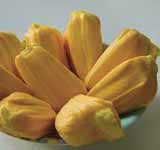
The Jackfruit tree is branched, cozy and multi-yearly tree. It is native to South and Southeast Asia. Its fruit is the largest in the world on tree fruits. Small thorns are found on the outer surface of the fruit. This type of stored fruit is called sorosis. The Latin name of jackfruit is Antiaris toxicaria. Its leaves range from 10 cm to 20 cm long, some wide, slightly oval and slightly blackish green. In the Jackfruit, flowers are placed on pillars and thick branches. Flowers are from 5 cm to 15 cm long, 2-5 cm round oval and slightly yellow in color. The fruit of the jackfruit is very large-long-circular rounds.
8. Kinnow
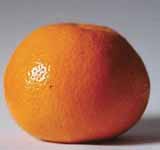
9. Lemon
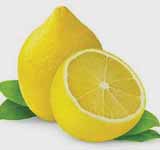
10. Lychee
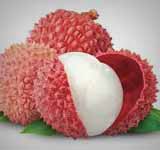
The lychee (Litchi chinensis) is an evergreen, up to 30 m high tree with a dense, broad crown. The scattered, alternately placed leaves are 12-25 cm long and have an odd or even spring suspension. The 4-8 leaflets are egg-to-lance-shaped, focused, 6-15 cm long and 1.7-4 cm wide. They are thin-leathery, intact, shiny dark green on the top and gray-green on the bottom. The flowers grow in screen-like, branched, terminal, hanging up to 70 cm long inflorescences. The flowers have four yellowish or greenish sepals and no petals.
11. Papaya
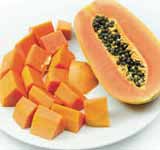
Papaya is a fruit. It is green in raw state and becomes yellow on ripening. Both its raw and ripe fruits are used. Vegetable made by raw fruits. For these reasons, it is a very good to applying near home. The milk is also extracted from its raw fruits, which makes papins ready. Digestive drugs are prepared from Papine. Papaya enhances digestive power. Therefore, consuming its ripe fruit is beneficial for the stomach. Papaya is grown in all the hot climate regions.
12. Peach

13. Pear
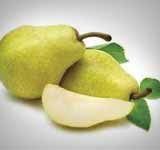
Pear, Pyrus, is a plant genus from the rose family (Rosaceae) that produces the well-known fruits. The genus occurs in many countries, especially in the northern hemisphere. The inflorescence of the plant genus pear is a tree that blooms every year in old age and, usually also every year, bears fruit. High-stemmed trees bloom later in life than so-called spindles. However, turn years also occur. Depending on the variety, the tree blooms on average from mid-April to early May. Due to the early flowering, night frost damage may occur during flowering, as the flowers freeze and therefore cannot grow into fruits. For good pollination it is usually necessary to plant several varieties together. There are also varieties, such as Conference, that can form parthenocarpous fruits.
14. Raspberry
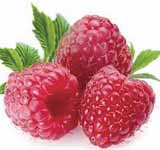
15. Sugar-apple
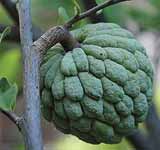
16. Sweet limetta

17. Tamarind
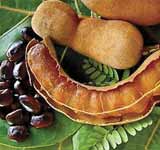
18. Watermelon
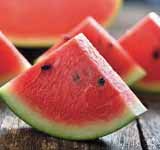
The watermelon is a one-year-old, single-headed plant from the Cucurbitaceae family with large, gray-green lobed leaves. The flowers are single and yellow to white in color. The fruits, which can vary in weight from 1 to 50 kg depending on the variety, contain moist, sweet flesh. The pulp is in the flesh, which is usually red, but can also be white, pink, yellow or orange. The red flesh contains the highest content of lycopene of all raw consumed fruits (if a tomato is cooked, it contains relatively more lycopene).
19. Pomegranate
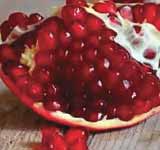
The pomegranate (Punica granatum) is both the one to six meter high shrub with long, thorny branches and the fruit of this shrub. The plant belongs to the cattail family (Lythraceae) or the Punicaceae family (order is under revision). The plant can have its leaves in dry timesto lose. The short-stemmed, glossy, green leaves grow opposite and close together. The leaves are oval and with a cool edge. They are 0.5-2.5 x 1-10 cm in size. The orange-red flowers form at the tips of the shoot or on short side shoots in groups of one to five. Subspecies that are fairly frost resistant occur on several Greek islands. These grow primarily in the mountains.
20. Apricot

21. Bengal currant

22. Citron

23. Custard apple

24. Fig

25. Kiwifruit

26. Muskmelon

27. Nutmeg

28. Plum

29. Sapodilla

30. Star fruit

31. Tangerine

Mango is a kind of lush fruit. It also called the king of fruits in India. Its native species is called Indian mango, whose scientific name is Mangifera indica. Mango species are called mangifera. The species of this fruit first came only in the Indian subcontinent, after which it gradually spread to other countries. Most of it is produced in India. It is considered a national fruit in India, Pakistan and the Philippines and its tree in Bangladesh has the national tree status. In the Indian subcontinent, thousands of years ago people had come to know about mango and it was cultivated. It reached the Southeast of Asia from the fourth to the fifth century. Its cultivation began in East Africa till the tenth century. In the 14th century, it reached Brazil, Bermuda, West Indies and Mexico.
33. Apple
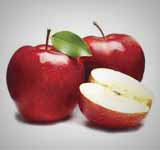
The apple is the fruit of the Malus domestica plant from the rose family (Rosaceae). The fleshy fruit consists of three layers, but sometimes two or three layers form one whole and cannot be recognized separately. In the case of the apple, the exocarp and mesocarp can no longer be distinguished from each other and, together with the swollen flower bottom, the flesh forms. The core is the endocarp containing the seeds and in the middle the vascular bundle to the stem.
34. Banana
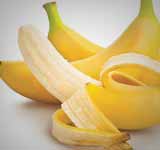
A banana is an elongated, slightly curved fruit that comes from the banana plant. In Suriname we speak of bacove when it is the fruit that can be eaten straight from the peel and banana when it comes to green plantains. In Indian dishes the banana is usually called pisang, the Malay word for the fruit. The word is also known in Afrikaans, but then spelled piss. A banana plant or banana tree is actually an herb, the world's largest herb (herbaceous). According to the horticultural definition, however, the banana is counted among the vegetables. According to the culinary definition, however, it is a fruit, because the banana is eaten as a dessert or as a snack.
35. Date
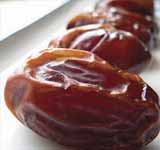
36. Lime

37. Orange
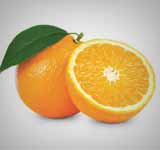
The orange or sweet orange is the fruit of the orange (Citrus sinensis L.) of the family Rutaceae. As with all citrus fruits, this is a particular form of berry called hesperide. There are several varieties of oranges classified into four varietal groups. Edible, it is known for its high content of vitamin C, although the latter is not particularly high compared to other fruits and vegetables. It is the fourth most cultivated fruit in the world. Orange has given its name to the secondary color which, on the chromatic circle, takes place between red and yellow.
38. Phalsa
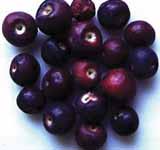
39. Pineapple
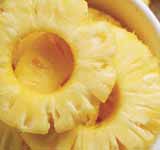
Pineapple is the common name of a food tropical plant and its fruit. It is basically the result of Paraguay and southern Brazil. Pineapple is also eaten by cutting fresh and is preserved in a shell or even after taking juice, it is also consumed. After eating, it is also used in the form of sweet as a salad and as a substitute for meat-free cocktails. In a dessert form this is the high level of acidic nature (possibly malic or citric acid). Pineapple is the only fruit of Bromeliaceae family grown in agriculture.

